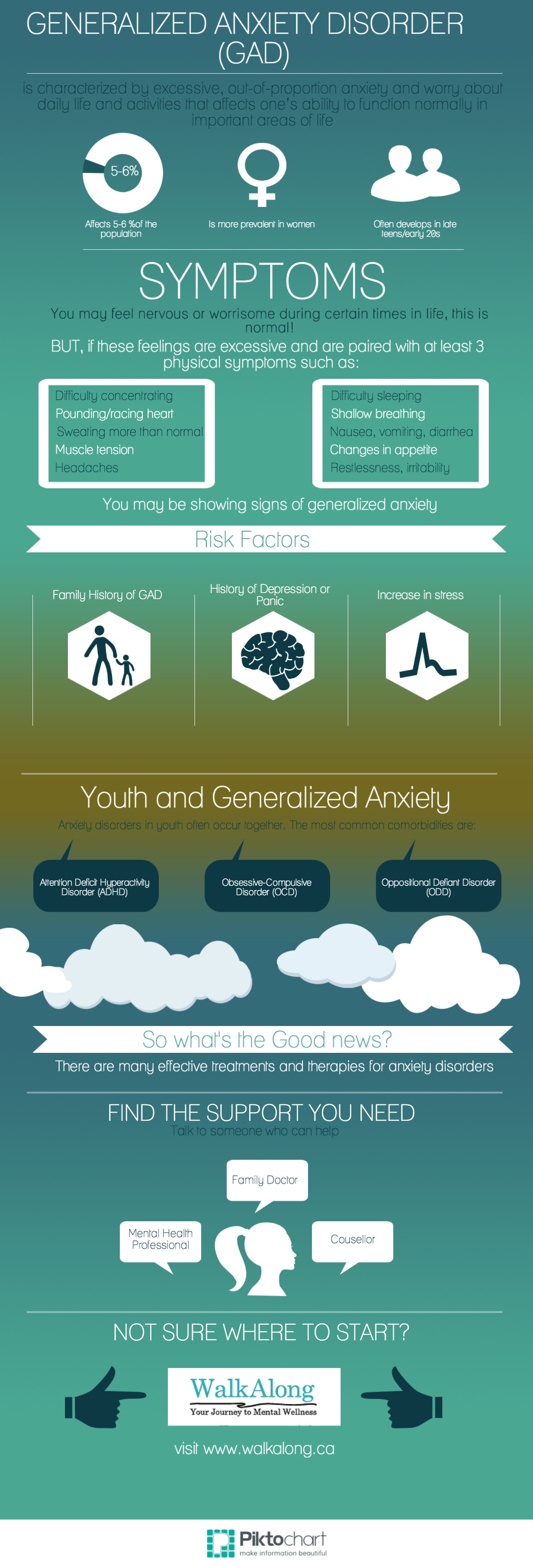Generalized Anxiety Disorder (GAD)
Photo by CraigCloutier
Generalized Anxiety Disorder (GAD) is an anxiety disorder characterized by excessive, out-of-proportion anxiety and worry about daily life and activities that affects one’s ability to function normally in important areas of life. GAD is also normally accompanied by physical symptoms.
Overview
Symptoms
Diagnosis
Causes/Why Me?
Epidemiology
Treatment Approaches
What Can I Do For Myself?
Risk Factors
Comorbidities
Youth Specific Features
Summary
Infographic
Generalized Anxiety Disorder (GAD) is an anxiety disorder characterized by excessive, out-of-proportion anxiety and worry about daily life and activities that affects one’s ability to function normally in important areas of life. GAD is also normally accompanied by physical symptoms. Anxiety disorders are the most common mental health problem, and it is estimated that 1 in 10 Canadians are currently suffering from an anxiety-related disorder. Epidemiologic surveys and clinical studies have shown that GAD tends to develop between the late teens and late 20s, and is a chronic disorder that can persist for more than a decade.
Someone with GAD experiences excessive, out-of-proportion anxiety and worry about daily life events/activities that is difficult to control. This anxiety occurs alongside three or more of the following physical symptoms:
- Pounding/racing heart
- Difficulty concentrating
- Sweating more than normal
- Muscle tension
- Headaches
- Difficulty sleeping (difficulty falling asleep, staying asleep, or restless unsatisfying sleep)
- Shallow breathing
- Nausea, vomiting, diarrhea
- Restlessness or edginess
- Irritability
- Changes in appetite
Mental health professionals identify a person as having GAD when he/she experiences intense and constant feelings of anxiety to the point of creating significant distress and some degree of functional impairment in areas of life such as social interactions, family relationships, work or school. These feelings of anxiety are likely also coupled with several physical symptoms. The symptoms will have been prevalent and more or less constant for at least six months.
The focus of the anxiety/worry cannot be the result of medication, another medical problem, substance abuse, or another Axis I disorder (e.g. the anxiety of a person with Panic Disorder who worries about having a panic attack, the anxiety of a person with Anorexia Nervosa who worries about gaining weight, etc.) [Read More].
Click here to view the DSM-IV diagnostic criteria for Generalized Anxiety Disorder.
More resources
Clinical Practice: Generalized Anxiety Disorder
Anxiety Disorders Association of Canada
Genetics
Research suggests that genetic factors are largely responsible for Generalized Anxiety Disorder. Males and females share the same genes that predispose someone to developing GAD. [Read More]
A high genetic correlation between the personality trait neuroticism and the development of several Axis I disorders (including GAD) has also been found [Read More].
Life experiences
Bad experiences with a certain place, person or social setting can colour the way you think about and react to those situations in the future (e.g. almost drowning could make you very afraid of water, being bullied could result in you avoiding social situations). Anxious behaviours can also be learned by observing other people’s anxious behaviours. For example, if you have a parent with anxiety disorder who gets very anxious in social situations, you too may ‘learn’ these anxious behaviours and become uncomfortable in social situations [Read More].
Substance abuse, including tobacco and pre-existing anxiety disorders and depression can also increase the likelihood of experiencing GAD.
What is epidemiology? Epidemiology is the study of the prevalence of disease in different populations and why [Read More].
Anxiety disorders are the most common mental health problem, and it is estimated that 1 in 10 Canadians are currently suffering from an anxiety-related disorder. Epidemiologic surveys and clinical studies have shown that GAD tends to develop between the late teens and late 20s, and is a chronic disorder that can persist for more than a decade [Read More]. GAD appears to develop independently from education, marital status, social class, or race; however it has a significantly higher prevalence in women [Read More].
Cognitive behaviour therapy (CBT)
What is CBT? CBT is a proven-to-work treatment that focuses on learning how to perceive and approach situations that make you anxious. It focuses on the belief that your thoughts (cognitive) influence the way you act (behavioural), and works on changing the way you perceive situations and yourself in order to manage your anxiety.
Treating substance abuse
Substance abuse is often comorbid with GAD. Taking steps to treat substance abuse may reduce symptoms associated with GAD. [Read More]
Pharmacotherapy
Pharmacotherapy is the treatment of a disorder using medication. Antidepressants (such as tricyclic antidepressants, selective serotonin-reuptake inhibitors and serotonin-norepinephrine-reuptake inhibitors) are sometimes prescribed to treat GAD, as anxiety tends to coexist with depressive disorders [Read More].
Psychoeducation
Psychoeducation is where you educate yourself to understand more about a certain disorder. Learning about anxiety can help you feel more in control of your situation and reduce some of the stress that comes with it.
Relaxation
Muscle tension and shallow breathing are physiological responses to anxiety. Learning how to identify these symptoms and calm the body can alleviate anxiousness. Calm breathing and progressive muscle relaxation are two techniques used to alleviate anxiety.
Listen to a calm breathing exercise or a progressive muscle relaxation that we’ve created here.
Realistic Thinking
One way to manage anxiety is to replace negative thinking with realistic thinking. Realistic thinking involves looking at a situation from different perspectives, and learning how to identify the positive, neutral and negative aspects of a situation instead of just the negative. Because GAD often skews one’s perspective of everyday events, the goal of realistic thinking is to think of these events in an unbiased way.
Exposure
Face your fears! Facing your fears involves progressively exposing yourself to situations that you are afraid of, in order to make yourself less anxious of these situations over time.
Exercise
Exercise can help stabilize and elevate your mood and improve overall health (both physical and mental) [Read More].
Family history of GAD, an increase in stress and a personal history of major depression or panic disorder all contribute to the likelihood of a person developing GAD [Read More].
What is comorbidity?
Substance abuse (including tobacco) increases the likelihood of experiencing GAD. Some people with Generalized Anxiety Disorder may also experience other anxiety disorders at the same time, such as Post-traumatic Stress Disorder, Panic Disorder and Social Anxiety Disorder. Research suggests that GAD is rarely present as the only psychological disorder in a person but tends to be comorbid with a variety of other disorders [Read More].
More resources
Anxiety Disorders in Primary Care: Prevalence, Impairment, Comorbidity, and Detection
Youth-Specific Features of Anxiety Disorders
Anxiety disorders are one of the most common problems affecting children and adolescents. Disorders not treated during childhood may result in adult anxiety or depression [Read More]. Anxiety disorders in youth often occur together. The most common comorbidities are ADHD, ODD and OCD.
Youth-specific resources:
AnxietyCanada
AnxietyBC
Generalized Anxiety Disorder (GAD) is an anxiety disorder that has a lifetime prevalence of about 5% in the population. It is characterized as excessive, out-of-proportion anxiety and worry about daily life and activities that affects one’s ability to function normally in important areas of life. GAD is normally also accompanied by physical symptoms such as difficulty sleeping and concentrating, irritability, heart palpitations, and other problems. For a person to be diagnosed with GAD, they must have experienced these consistent, uncontrollable feelings of anxiety as well as physical symptoms for more than 6 months, and this anxiety cannot be the result of other mental disorders, substance abuse, or medical problems in order to be diagnosed as GAD. GAD can be the result of both genetics and life experiences, and people with a history of substance abuse or other mental disorders (e.g. depression) can be predisposed to developing anxiety. The onset of the disorder tends to be between the late teens and late 20s, and GAD is often present alongside other disorders. Treatment options include Cognitive Behavior Therapy (CBT), treatment of any potential substance abuse, and pharmacotherapy.



